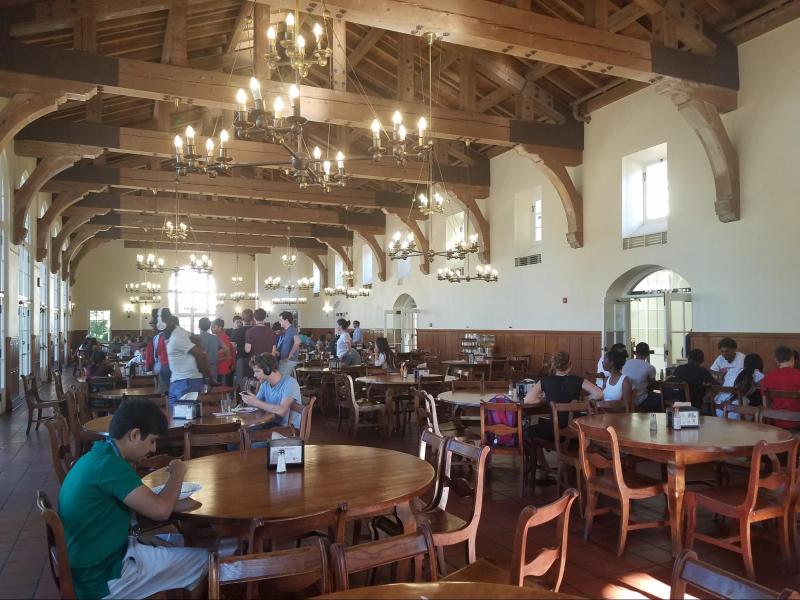For students seeking to take classes, conduct research or participate in programs or internships at Stanford this summer, the question of where to live on campus — and at what price — is a prevalent one. The Daily spoke with students about the benefits and drawbacks of different housing options with respect to pricing, community and privacy.
The summer housing options available to students include the Mirrielees apartments, residence halls and co-operative housing.
Meal plan
When choosing summer housing, an important factor for many students is Stanford’s meal plan. Only students who live in residence halls, but not co-ops or apartments, are required to purchase a Stanford meal plan.
While the meal plan poses no financial barrier for some, there are others who prefer to eat, cook and live on their own in order to save money. The cost of the summer meal plan ranges from $940 to $2,046, depending on the number of weeks each student lives on campus and the number of meals per week.
Stanford’s Residential & Dining Enterprises (R&DE) cites administrative costs associated with the two dining halls open to Stanford students during the summer, Lakeside Dining and the Arrillaga Family Dining Commons, as a primary reason for the meal plan requirement.
“The dining halls serve a variety of functions, including as spaces for programs, for study and for meetings, whether students eat there or not,” a statement on R&DE’s website reads. “There are administrative overhead costs — such as utilities — associated with keeping the space open, and these costs are funded entirely by meal plan fees. Requiring a meal plan ensures enough participation in the dining program to make serving meals — and keeping these important spaces open — financially sustainable.”
According to Daniel Ryder, a sophomore from Amador Valley High School, the dining hall food is “very diversified,” offering a range of options.
“The food is very much geared towards being nut-free and healthy,” Ryder said. “If you want a hamburger, you can get it. If you want pizza, you can get it. If you want … Asian food, you can get it.”
Some summer residents agree that the meal plan, albeit mandatory, is actually worth the price.
“I think [the meal plan is] pretty helpful,” said Nicholas Hersperger, a sophomore from the University of Wisconsin-Eau Claire who is living at Stanford this summer. “Meal options in this area are quite expensive compared to the meal plan here.”
The Mirrielees apartments are an example of an exemption to the summer meal requirement. Students who opt out must find their own means of obtaining food. Despite the money saved on the meal plan, some tenants say that the option has its shortcomings.
“[Cooking food is] a little bit more time consuming than going to a dining hall and just getting a meal, but also you get a lot more autonomy,” said Cale Lester ’19, currently a resident in Mirrielees. “You get to pick what you are going to eat [but] personally, you can really easily make higher quality food on your own dollar.”
Lester usually gets his food from stores like Trader Joe’s and Walmart. For residents who do not have easy access to transportation, however, procuring food proves to be a challenge.
“I don’t have a car, so I have to go [get food] when my friends are going or go on a bike and get less stuff,” said Annika Brakebill ’19, a resident of Mirrielees. “It would be hard if I’m running low on time.”
In-house community
In addition to the meal plan exemption, Mirrielees tenants live in two or three bedroom apartments, allowing each student their own space.
“It’s nice to have your own bedroom,” Stanford visitor and former student Gabe Knight ’17 said. “It’s one of the few places you get your own bedroom here.”
For other residents, the living arrangement at Mirrielees can make it hard to meet new people.
“I’ve noticed there’s not really a community so far,” Lester said. “I don’t know what I would do if I didn’t have friends that I knew that were living in here. That would be a little weird, for sure.”
In residence halls, on the other hand, students said that the proximity of tenants fosters friendship and community.
“I can talk to my friends; they live next to each other,” said Hikaru Shimada, a student from Saint Maur International School in Tokyo. “I can have lots of friends [and] start new connections.”
Aside from the two aforementioned housing options, co-operative housing is available to students who choose to live in 576 Alvarado. This type of housing, according to Stanford’s website, is a “student-managed” residence where tenants collaborate to keep operations running. Among these operations are food purchases, management of finances and job coordination.
Contact Ayden Salazar at aydensalazar09 ‘at’ gmail.com
